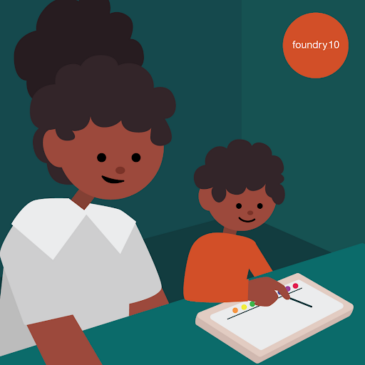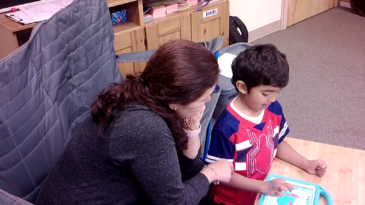While young children are off school over winter break, many families will be looking for activities to keep kids learning and having fun. On cold winter days, creating art or music together using a touchscreen app is one way for caregivers to connect and support the cognitive and social development of their early learners.
 Research on Joint Media Engagement (JME) from the Joan Ganz Cooney Center demonstrates that media can provide important social, emotional, and cognitive experiences for children when shared with family. The term Joint Media Engagement describes what happens when people learn together with digital or traditional media. Parents can directly influence their young children’s learning when they engage in activities together such as watching movies, reading books, or playing with apps on a touchscreen device like a tablet or smartphone.
Research on Joint Media Engagement (JME) from the Joan Ganz Cooney Center demonstrates that media can provide important social, emotional, and cognitive experiences for children when shared with family. The term Joint Media Engagement describes what happens when people learn together with digital or traditional media. Parents can directly influence their young children’s learning when they engage in activities together such as watching movies, reading books, or playing with apps on a touchscreen device like a tablet or smartphone.
However, few apps are specifically designed to support JME between parent and child. Design features like fast pacing, limited user roles, and awkward shared positioning can make it difficult to play together. Even when the design of the app is more JME-friendly, young children often resist parent involvement, causing conflict and discouraging co-play.
At foundry10, an education research organization based in Seattle, we sought to learn more about how app designers and parents can better facilitate JME when using apps with children. In an observational lab study, “Let’s Draw Chocolate Milk Together, we analyzed the behavior of parents and children ages 4-5 while they played together with two artistic production apps.
DoodleCast is an open-ended drawing application with options for starting including storytelling prompts, a blank page, or a photograph taken by the user. The app includes a color palette and drawing tools. The drawing process is recorded, with sound, for playback and can be used for creating a message or story.
Pitch Painter is an open-ended music composition application in which drawing with different colors and corresponding instruments on a grid creates music that can be played back in different ways.
We chose to use creativity apps for this research that were grounded in constructivist and constructionist theories of learning, because they met several JME design criteria such as allowing both partners to enjoy the experience, create together, contribute to the creation in their own ways, connect their creations to the real world, and talk as they create.
Parent Strategies for Playing Apps with Kids
In our study, we found that co-play rarely happened without parent facilitation. By utilizing the following strategies, parents have the potential to make family playtime with apps more enjoyable and expand the social, emotional, and cognitive benefits of JME in the future.
- Choose apps wisely
Decide what app you will play together and for how long. Choose apps that allow you to create something like a drawing, song, story, or other kind of art. In addition to DoodleCast and PitchPainter, other great apps for artistic co-creation include: Lipa Theater, Relationshapes, LiveDoodle, Elmer’s Photo Patchwork, Singing Fingers, and Loopimal. - Find a comfortable shared position
Next, find a comfortable shared position that makes it easy to play together. For example, put the tablet on your lap and let your child play, or let your child hold the tablet and sit so you can reach the screen. Encourage your child to take turns with you. - Let your child lead
While parents and children can take turns as equal partners, most young children prefer to take the lead while parents coach. Parents can facilitate JME by following along with the child’s creation process (e.g., using the eraser to clean up mistakes as the child draws) or helping to make something that was not originally intended by the app design (e.g., filling in the entire drawing space with one color). - Assist with technical challenges
With parent assistance, children can accomplish tasks that are too challenging to figure out alone. In our study, when parents offered support using Pitch Painter by showing the child the association between colors and instruments or the various replay options in the sidebar, children stopped playing to listen and engage with their parents. - Make connections
Ask your child to show you what they made. Help your child see connections between the app and their own memories or things you do every day. For example, “Let’s write your name.” or “Does this game remind you of when we went grocery shopping yesterday?”
These parent strategies can go a long way to facilitate family JME. But app developers can take artistic co-creation apps even further by implementing a few key design features.
Design Criteria to Promote Joint Media Engagement
In our research, we identified 16 design criteria for JME by evaluating eight sources with overlapping research findings. We used these criteria to select the artistic co-creation apps for the study and share them here for further reference. To promote family JME, digital media should:
- Be child interest-driven
- Be developmentally appropriate
- Be free from distractions like pop-ups
- Be interactive
- Have simple controls / be user-paced
- Have a theoretical grounding in the learning
- Include multiple planes of engagement
- Support co-creation
- Encourage shared positioning
- Support different roles for partners
- Connect to the real world
- Promote joint attention, collaboration, and dialogic inquiry
- Provide structure for adult scaffolding or self-exploration sciences
- Allow child to grow/develop through use
- Provide contingent, meaningful feedback all partners enjoy the experience
- Fit into family culture, values, and norms
Design Features to Facilitate Family Co-Creation

Prompts for turn-taking
Parent-led co-creation was particularly successful when parents used the strategy of promoting and structuring turn-taking and shared positioning of the device. Designers could support their effort by providing “scaffolds to scaffold” within the app like explicitly prompting two users to take turns or hold the device in a shared position.
Prompts for child to ask for help
Any app features or tasks that prompt children to seek assistance can facilitate joint play. We observed that children stopped playing and listened to parents when parents offered technical assistance with the device or app features that supported children’s goals for their play. Design possibilities to facilitate this kind of engagement include non-transparent features adults and children can explore together, a challenge or task that can only be solved with the help of a caregiver, or perhaps an explicit prompt to work together.
Prompt for Co-Players to Make Connections
Although parents can and should support children to make connections between digital media experiences and their everyday life without prompting from apps, in-app features can help. Prompts where co-players are encouraged to make connections and tap into everyday experiences that are inherently interesting to children could facilitate JME.
Artistic co-creation apps are a great way for parents and young children to play and learn together. By using effective parent strategies and evaluating current apps on the market for JME-conducive design, playing together on apps can be an excellent way for families to connect at home.
 Riddhi Divanji is a research coordinator at foundry10. She is interested in evaluating youth outcomes, exploring how learning takes place within and across settings, and building community partnerships to better support young people as they move through their education. Her current projects involve exploring the implementation of emerging technologies in K-12 classrooms and the development of social-emotional and academic intervention programs.
Riddhi Divanji is a research coordinator at foundry10. She is interested in evaluating youth outcomes, exploring how learning takes place within and across settings, and building community partnerships to better support young people as they move through their education. Her current projects involve exploring the implementation of emerging technologies in K-12 classrooms and the development of social-emotional and academic intervention programs.
 Samantha Bindman is a Director of Research at foundry10. Sam’s current projects include exploring EdTech tools and successful classroom implementation and value for learning, the promise of dramatic arts for engaging young children in learning, and the role of technology in family life.
Samantha Bindman is a Director of Research at foundry10. Sam’s current projects include exploring EdTech tools and successful classroom implementation and value for learning, the promise of dramatic arts for engaging young children in learning, and the role of technology in family life.
 Sydney Parker is a Staff Writer at foundry10. Prior to joining the organization, Sydney wrote about people, education, and comedy for publications including The Guardian, The Atlantic, Seattle’s Child Magazine, Real Change News and more.
Sydney Parker is a Staff Writer at foundry10. Prior to joining the organization, Sydney wrote about people, education, and comedy for publications including The Guardian, The Atlantic, Seattle’s Child Magazine, Real Change News and more.
 Kiley Sobel is Senior User Experience Researcher at Duolingo. Previously, Kiley worked at the Joan Ganz Cooney Center as a Research Scientist. Throughout her career, Kiley has conducted integrative research about kids, families, co-design, collaborative play, learning, disability, accessibility, and inclusion.
Kiley Sobel is Senior User Experience Researcher at Duolingo. Previously, Kiley worked at the Joan Ganz Cooney Center as a Research Scientist. Throughout her career, Kiley has conducted integrative research about kids, families, co-design, collaborative play, learning, disability, accessibility, and inclusion.

